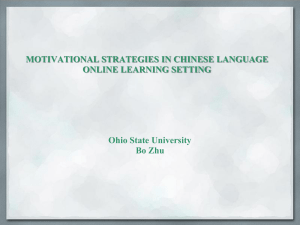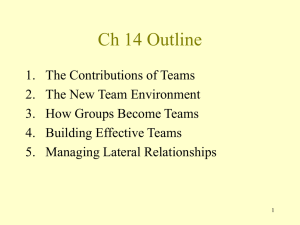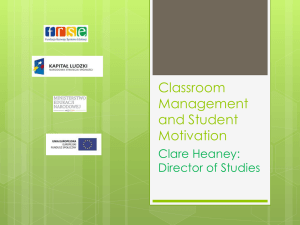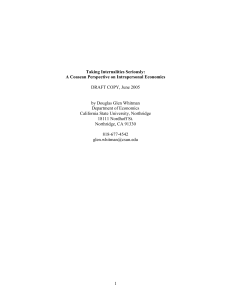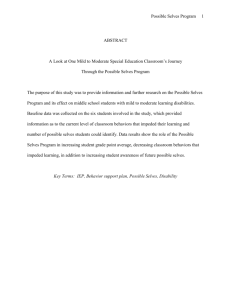techniques-for-motivating-the
advertisement
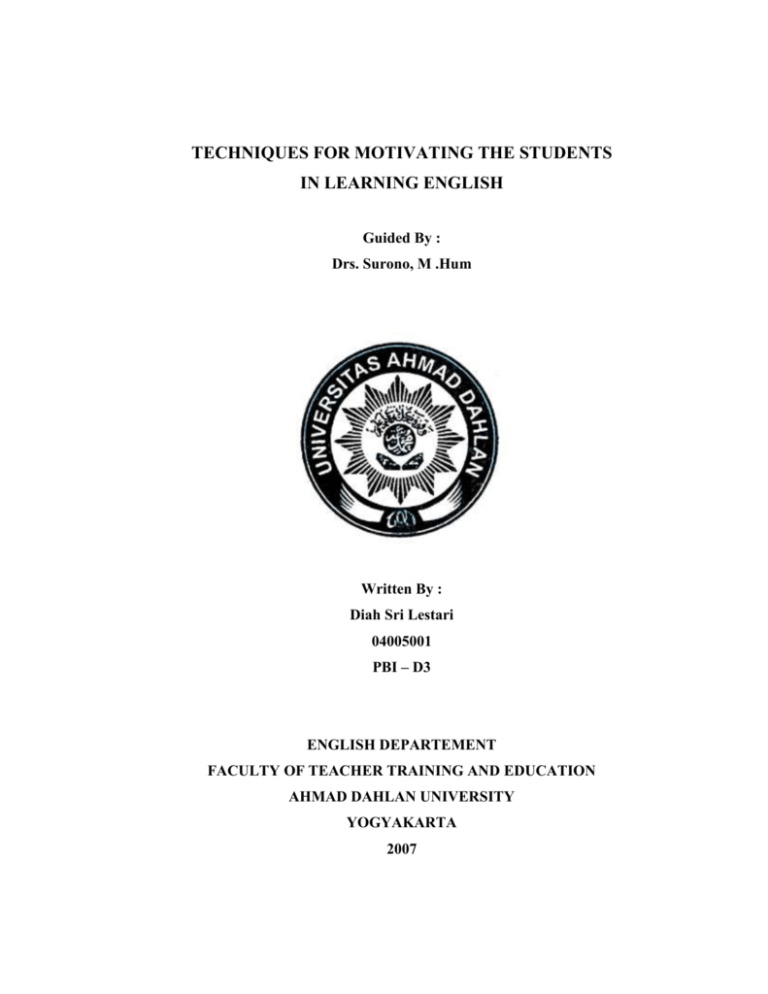
TECHNIQUES FOR MOTIVATING THE STUDENTS IN LEARNING ENGLISH Guided By : Drs. Surono, M .Hum Written By : Diah Sri Lestari 04005001 PBI – D3 ENGLISH DEPARTEMENT FACULTY OF TEACHER TRAINING AND EDUCATION AHMAD DAHLAN UNIVERSITY YOGYAKARTA 2007 CHAPTER I INTRODUCTION A. Background of the problem In Indonesia, English is the first foreign language that is taught from elementary school until university. English as a school subject has been introduced in elementary school because learning a foreign language is better when it is done as early as possible. Brown (1980: 2) states that common observation shows that children are “Better” language learners than adults. Motivation is needed very much in language learning. Motivation is a power which gives desire to the students so they have awareness that language learning is their responsible. Motivation will be an important thing makes students fall or success in their learning. They learn English because they want to get a good mark and pass the exam, they don’t know that in learning English, it will be success if they can use it, so the teachers should change this motivation by giving spirit and information that English is very useful in order they will have an integrated motivation. Students with an integrated motivation will have greater success in learning English than those with merely instrument motivation, a students with an integrated motivation will be active in improving this English not only in class out of class as well. According to Donn Byrne (1976:15) the motivation for the learners should be pleasure, interest, and a growing confidence at being able to understand the spoken language without reference to the written form. Beside, also factor a learner to increase student motivation to drive student to active in learning English language in the class. In learning process teacher and students can’t be separated teacher need students and student does too. A good relationship between teacher and students will influence in the result of learning process. If there is a good relationship between teacher and students, they will feel comfortable in the learning teaching process. To build a good relationship between students and teacher, in the relation with the role of the students and the role of teacher need cooperation and communication between them. Teacher does everything that he can do to help the students to get what they want in other hand students should tell what he want. So, the teacher knows what he should do. In this case it will better if they take and give each other. As a new subject, English is a new thing to elementary school students who are taught the subject for the first time. Consequently, they have difficulty in understanding the lesson material. The students who have known and understood it before can answer the teacher’s question and they will be more active than the students who do not know it before. They are inclined to keep silent and make noise in the classroom. In fact, English teaching learning process in unsuccessful in elementary school. It can be seen from the result of the test of final examination in the school which does not show satisfactory result. Maybe, it is caused by the low motivation and interest in learning English. In relation with the English learning process, there are many ways that can be used to get the high achievement. Giving motivation and growing interest in learning is one of the ways to increase the students learning achievement. It is expected that students will be more active and they can complete with their friends to get high achievement. Why are some students successful at language learning whilst others are not? If we know the answer to that question the job at teaching and learning a language would be easy. We do not, of course, but we can point to a number of factor which seem to have a story effect on a students success or failure. One of the effect is motivation. According to Jeremy Harmer (1991: 3) there are two type of motivation which is concern with factors outside the classroom. The second, intrinsic motivation which in concern with factors inside the classroom. In order that the problem is more focused, it is necessary to limit the problem such as, extrinsic and intrinsic motivation. The first, extrinsic motivation which is concern with factor out our selves. The second, intrinsic motivation which is concern with factors in our selves. For them what happens in the classroom will be a vital importance in determining their attitude to the language, and in supplying motivation, which we have suggested that it will be a vital component in successful language. B. Formulation of the Problem Based on the limitation of the problem, the writer formulates the problem: 1 What can increase the students motivation in learning English? 2 What techniques can be used to motivate the students in learning English? C. Significance of the Study 1. For Teacher : a. To increase inspiration lectures to include the topic in learning teaching English. b. To drive in learning English motivate. 2. For Students : a. To increase in learning English b. To interest in learning foreign language c. To motivate in learning English. CHAPTER II DISCUSSION A. Definition of Motivation Motivation is one of the psychological factors that give effect to language learning. It is easy in second or foreign language learning to claim that a learner will be successful with the proper motivation. Some addition to Mc Donald in Soemanto (1990:173) Motivation is an energy change within the person characterized by affective arousal and anticipatory goal reaction. From the definition above motivation has three aspects the first, motivation is the beginning of energizing changer from the person. The second, motivation is marked by the affective arousal. The third, motivation is marked by the reaction to achieve a goal. There are also Eggen and Kauchak (1994:427) State that motivation is a force that energizes, sustains, and directs behavior toward a goal. B. Learning Motivation According to Brown (1980:160) motivation is probably the most frequently used catch all term for explaining the success of failure of virtually any complex task. It is easy to assume that success in any task is due simply to the fact that someone is motivated” it is easy in second language learning to claim that a learner will be successful with the proper motivation. People involved in language teaching often say that student who really want to learn will succeed whatever the circumstance is. All teachers can think of situation in which certain “motivated” student significantly better than their peers. They succeed in what appears to be an unfavorable condition. They succeed despite using methods which experts consider unsatisfactory. In the face of such phenomena it seems reasonable to suggest that the motivation that student bring to class is the biggest factor affecting their success. Motivation is one of the psychological factor that give effect to language learning. It is easy is second or foreign language learning to claim that a learning will be successful with the proper motivation. There are two motivations, such as : 1. Intrinsic motivation, which is concern with factor in our selves. 2. Extrinsic motivation, which is concern with factor out our selves. 1. Intrinsic motivation which is concern with factor in our selves. According Ahmadi and Supriyanto (1990:130-131) state that there are two factor influence learning achievement, they are internal factor and external factor. This is internal factor motivation such as: a. Physical condition Physical condition has a great effect on learning an can after a student’s motivation either positively or negatively. b. Method The method by which students are tough must has same effect on their motivation. If they find it deadly boring their probably de-motivated, whereas if they have confidence in the method they will find it motivating. c. The Teacher Where the student likes or not may not be very significant. What can be said, is that the two teacher use the same method. The result can be vastly different results. d. Success Success plays a vital part in the motivational drive of a student. It will be the teacher’s job to set goals an tasks at which most of his or her student can be success. 2. Extrinsic motivation which is concern with factor in out our selves one of the best known studies of motivation in second/foreign language learning was carried out by Gardner and Lambert in Brown (1980:114-115). Motivation was examined as a factor of a number of different kinds of attitudes. Two different clusters of attitudes divide two basic types of motivation: a. Integrative motivation For this kind of motivation student need to be attracted by the culture of the target language community (TLC), and in the strong form of integrative motivation they which to integrate them selves into the culture. b. Instrumental motivation This term describes a situation in which student believe that mastery of the target language will be instrumental in getting them a better job, position or status. The language is an instrument in their attainment of such a goal. C. English Learning English Learning Achievement The nature of English learning achievement learning. Learning is called a process because it is formally comparable to other organic processes such as digestion and respiration. The process of learning is doing, reacting, undergoing and experiencing. Experiencing means living through actual situation and reacting vigorously to various aspect of those situations. It can be conclude that learning is an activity that result in a change to the individual in the learning. The aspect of change are concerned with intellectual skills showing the extend of the student’s capability. Learning is process of acquisition and extinction of modification in existing organism through experience practice or exercise. Factors Affecting English Learning Achievement, such as : 1. An active approach in learning task 2. A personal learning style or positive learning strategy 3. Willingness to practice 4. Willingness to use the language in real communication. D. English Learning Motivation In English teaching learning process is unsuccessful in elementary school. It can be seen from the result of test or final examination in the school which does not show satisfactory result. Maybe, it is caused by the low motivation an interest in learning English. In relation with the English learning process, there are many ways that can be used to get the high achievement. It is expected that student will be more active and they can complete with their friends to get high achievement. Define that learning is some as a relatively change in behavior or performance that occurs as a result of experience, practice or exercise (Houston, 1976:25). There also a linguist Traphy (1976:4) define learning as a relatively permanent change in behavior which occurs as a result of experience learning represents a process by which on organism’s behavior is changed, but not all changes are from learning. E. Factors Influencing Learning Motivation Learning achievement of a person or learners can be influenced by many factors. Ahmadi and Supriyanto (1990:130-131) state that there are two factors influence learning achievement, they are internal and external factors. Internal factor is the factor that comes from inside of the person or learner. External factor is the factor that comes from out side of the person or learner. 1. Internal Factors a. Physical factor b. Psychological factor 2. External factors a. Social factor b. Culture c. Physical Environment d. Spiritual Environment of security F. Techniques for Motivating Technique for motivating is very important to every teacher because the motivating the students want to study hard and increase their mark. There are have two kinds of motivations : 1. Direct motivation Direct motivation is one of motivation which emerge straight from the teacher to the student in the classroom. For example : The teacher give a support when the student study in the class 2. Indirect Motivation Indirect motivation is one of motivation which emerge doesn’t straight from in the classroom but out class room. For example : The teacher give a homework to the students G. Ways of Motivating the Students In general strongly motivated students with long-term goals are probably easier to teach than these who have no such goals. For such students short-term goals will often provide the only motivation they feel. After we have a strong motivation the next step is how to increase the motivation no to be lost. There are three main categories to increase motivation, such as : 1. Try to get information as much as possible about that kind of activity. For instance if we want to learn English, try get information as much as possible about English. That information could be found from encyclopedia, teacher, or even try to discuss with other who knows English as well. 2. Do the relevant thing or activity. It means that if we have strong motivation to speak English well, we should do relevant things with English. For example, we join the English course, etc. 3. Try to talk with the native speaker, so we know to speak English right CHAPTER III CONCLUSION It can we conclude that English is important language used in this globalization era. English is very important, because it is an international language which is used as a means of communication with other people. Learning English consider are boring and difficult, so used some techniques for motivating the students in order to interest. The teacher will motivate the student so learn English with the appropriate teaching techniques student will enjoy and have some fun to learn English at their classroom, so they will feel that learning English is fun. Factors Influencing Learning Motivation There are two factors influence learning achievement, they are internal and external factors. 1. Internal factor is the factor that comes from inside of the person or learner. 2. External factor is the factor that comes from out side of the person or learner. Technique for motivating is very important to every teacher because the motivating the students want to study hard and increase their mark. There are have two kinds of motivations : 1. Direct motivation Direct motivation is one of motivation which emerge straight from the teacher to the student in the classroom. For example : The teacher give a support when the student study in the class 2. Indirect Motivation Indirect motivation is one of motivation which emerge doesn’t straight from in the classroom but out class room. For example : The teacher give a homework to the students The student more active with techniques for motivate from their teacher in the classroom, such as : 1. Try to get information as much as possible about that kind of activity. For instance if we want to learn English, try get information as much as possible about English. That information could be found from encyclopedia, teacher, or even try to discuss with other who knows English as well. 2. Do the relevant thing or activity. It means that if we have strong motivation to speak English well, we should do relevant things with English. For example, we join the English course, etc. 3. Try to talk with the native speaker, so we know to speak English right Bibliography Ahmadi, H.Abu & Supriyanto Widodo.1990.Psikologi Belajar . Jakarta : PT. Rineka Cipta Brown, H. Douglas. 1980. Principles of Language Learning and Teaching. Englewood Cliffs New Jersey. Prentice Hall Inc. Cameron, Lyne. 2001. Teaching Learning to young Learners. Combridge. Press Cyndicate university. Eggen, Poul and Kauchack, Don. 1994. Educational Psychology. Englewood Cliff New Jersey :Prentice Hal inc. Harmer, Jeremy. 1991. The practice of English Language Teaching. London : Longman. Houston, J.P. 1976. Fundamental of Learning. New York: Academic Press Inc. Sumanto, Wasti.1990 Psikologi Pendidikan, Jakarta : CV Rajawali Traphy, Roger, M.1976. Basic Principal of Learning. New York : Scott, Foresman Company.

